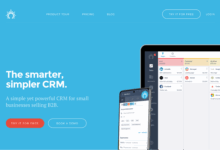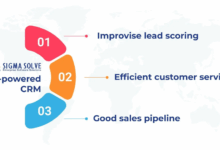CRM with AI Chatbot Integration: Enhanced Customer Engagement
CRM with AI Chatbot Integration represents a significant advancement in customer relationship management. By seamlessly blending the power of a robust CRM system with the intelligent capabilities of an AI-powered chatbot, businesses can unlock unprecedented levels of efficiency and customer satisfaction. This integration allows for automated responses, personalized interactions, and streamlined sales processes, ultimately leading to improved lead generation, increased sales conversions, and enhanced customer loyalty.
This synergy allows for 24/7 customer support, instant query resolution, and proactive engagement opportunities. The result is a more efficient and cost-effective way to manage customer interactions, while simultaneously improving the overall customer experience. This exploration will delve into the implementation, benefits, challenges, and future trends associated with this powerful technology combination.
Defining CRM with AI Chatbot Integration
Integrating AI-powered chatbots into Customer Relationship Management (CRM) systems is transforming how businesses interact with their customers. This integration leverages the strengths of both technologies to create a more efficient, personalized, and scalable customer service experience.
Core Functionalities of a CRM System
CRM systems are designed to manage and analyze customer interactions and data throughout the customer lifecycle. Core functionalities typically include contact management (storing and organizing customer information), sales force automation (managing sales processes and tracking leads), marketing automation (automating marketing campaigns and tracking results), and customer service support (managing customer inquiries and resolving issues). These functions work together to provide a holistic view of the customer, enabling businesses to understand their needs and preferences better.
Capabilities of an AI-Powered Chatbot
AI chatbots, powered by Natural Language Processing (NLP) and Machine Learning (ML), offer advanced capabilities beyond simple rule-based chatbots. They can understand and respond to complex customer queries, learn from past interactions to improve their performance, and personalize interactions based on individual customer data. Capabilities include 24/7 availability, immediate response times, handling multiple conversations simultaneously, integration with other systems (like CRM), and providing self-service options for common customer inquiries.
Enhancing CRM Functionality through Integration
Integrating an AI chatbot with a CRM system significantly enhances the CRM’s capabilities. The chatbot acts as a front-end interface, handling initial customer interactions and gathering information. This information is then seamlessly transferred to the CRM system, enriching customer profiles and providing valuable insights for sales and marketing teams. The integration streamlines workflows, reduces response times, and improves customer satisfaction by offering immediate support and personalized assistance. Furthermore, AI chatbots can analyze customer interactions to identify trends and patterns, providing valuable data for improving business processes and strategies.
Real-World Applications of CRM with AI Chatbot Integration
This integration finds applications across various industries. For example, e-commerce businesses use chatbots to handle order inquiries, track shipments, and provide product recommendations. In the financial sector, chatbots assist with account inquiries, transaction processing, and fraud detection. Healthcare providers utilize chatbots to schedule appointments, answer patient questions, and provide medication reminders. The versatility of this integration allows for tailored solutions across diverse business needs.
Comparison of CRM Systems with and without AI Chatbot Integration
| Feature | CRM without AI Chatbot | CRM with AI Chatbot |
|---|---|---|
| Customer Service Availability | Limited to business hours | 24/7 availability |
| Response Time | Can be slow, depending on agent availability | Instantaneous responses |
| Personalization | Limited personalization based on manual data entry | Highly personalized interactions based on AI analysis |
| Scalability | Scaling customer service requires hiring more agents | Easily scalable to handle increasing customer volume |
Benefits and Advantages
Integrating AI chatbots into your CRM system offers a wealth of benefits, significantly enhancing customer service, streamlining sales processes, and ultimately boosting your bottom line. The automation and personalization capabilities unlock efficiencies and improvements across various aspects of your business operations.
Improved Customer Service Through Automated Responses and Personalized Interactions significantly enhances the customer experience. This integration allows for immediate responses to common inquiries, resolving issues quickly and efficiently, leading to increased customer satisfaction and loyalty.
Enhanced Customer Service
AI-powered chatbots provide 24/7 availability, ensuring customers receive prompt assistance regardless of time zone or business hours. This instant support reduces wait times and improves response times, leading to higher customer satisfaction scores. Personalization is key; the chatbot can access customer data within the CRM to tailor responses, offering relevant product recommendations or addressing specific account details. For example, a chatbot could greet a returning customer by name and offer assistance based on their past purchase history, creating a more personalized and engaging experience. This level of personalization fosters stronger customer relationships and increases brand loyalty.
Impact on Lead Generation and Qualification
AI chatbots can significantly improve lead generation and qualification processes. By engaging website visitors in real-time, chatbots can collect valuable information, qualify leads based on pre-defined criteria, and route qualified leads directly to the sales team. This automation frees up sales representatives to focus on closing deals rather than spending time on initial lead qualification. Imagine a scenario where a chatbot on your website engages a visitor, asking qualifying questions about their needs and budget. Based on the answers, the chatbot determines if the lead is qualified and automatically forwards the information to the appropriate sales representative, ensuring a swift and efficient follow-up.
Streamlined Sales Processes and Increased Efficiency
Integrating AI chatbots streamlines various aspects of the sales process, boosting overall efficiency. Automated tasks, such as scheduling appointments, sending follow-up emails, and providing order status updates, free up sales representatives to focus on higher-value activities, such as building relationships and closing deals. This increased efficiency translates to higher sales conversion rates and improved revenue generation. For instance, a sales representative can use the chatbot to automatically schedule multiple client meetings throughout the day, saving significant time and effort compared to manual scheduling.
Cost Savings Associated with Automation
The automation provided by AI chatbots leads to significant cost savings. By automating routine tasks, businesses reduce the need for a large customer support team, leading to lower labor costs. Furthermore, the increased efficiency and improved lead qualification processes contribute to higher sales conversion rates, resulting in a better return on investment. A company that previously relied on a large call center might find that they can significantly reduce staffing levels while maintaining or even improving customer service levels with an AI chatbot handling many common inquiries.
Increased Customer Satisfaction Metrics
Numerous studies have shown a positive correlation between AI chatbot integration and increased customer satisfaction metrics. Faster response times, personalized interactions, and 24/7 availability contribute to higher customer satisfaction scores, improved Net Promoter Scores (NPS), and increased customer loyalty. For example, a company implementing an AI chatbot might see a 15-20% increase in customer satisfaction ratings within the first six months, demonstrating the tangible benefits of this integration.
Implementation and Integration Strategies
Integrating an AI chatbot into your existing CRM system can significantly enhance customer interactions and operational efficiency. Successful implementation requires a strategic approach encompassing careful planning, selection of appropriate tools, and effective training. This section details the key steps and considerations involved in this process.
Step-by-Step Guide for AI Chatbot Integration into CRM
Integrating an AI chatbot involves several distinct phases. First, a thorough assessment of your CRM system’s capabilities and limitations is crucial. This helps determine the best integration approach and potential challenges. Next, the selection of a suitable AI chatbot platform, considering factors like scalability, customization options, and integration capabilities, is paramount. Then, the actual integration process, which might involve API calls, pre-built connectors, or custom development, is undertaken. Following this, the chatbot needs extensive training using your CRM data to ensure accurate responses and efficient task handling. Finally, continuous monitoring and refinement are necessary to optimize chatbot performance and address any arising issues.
Factors to Consider When Selecting an AI Chatbot for CRM Integration
Choosing the right AI chatbot is vital for successful integration. Several critical factors must be considered. These include the chatbot’s natural language processing (NLP) capabilities, its ability to handle complex queries and tasks, its integration compatibility with your CRM system, the level of customization offered, the scalability of the platform to handle increasing volumes of interactions, and the vendor’s reputation and support services. Cost is another important aspect, balancing features and functionality with budget constraints. Finally, the availability of comprehensive analytics and reporting features to track chatbot performance is crucial for continuous improvement.
Comparison of Different Integration Methods
Several methods exist for integrating an AI chatbot with a CRM system. API integration offers the greatest flexibility and customization, allowing direct communication between the chatbot and the CRM database. This provides real-time data access and enables sophisticated automation. Pre-built integrations, offered by some CRM and chatbot vendors, provide a quicker and often simpler integration process, but might offer less flexibility. Custom development allows for highly tailored solutions, but typically requires significant development time and resources. The choice of method depends on factors like technical expertise, budget, and the level of customization required. For instance, a company with extensive in-house development resources might opt for custom development, while a smaller business might prefer a pre-built integration for ease and speed.
Training an AI Chatbot for Specific CRM Tasks
Training an AI chatbot for specific CRM tasks involves feeding it relevant data from your CRM system. This data might include customer interactions, product information, FAQs, and internal processes. The training process often involves supervised learning, where the chatbot is provided with example conversations and their desired responses. Reinforcement learning can also be used, where the chatbot learns through trial and error, receiving feedback on its performance. The chatbot’s knowledge base needs continuous updating to reflect changes in your business processes and product offerings. For example, if your company launches a new product, you’ll need to update the chatbot’s knowledge base with details about this product so it can accurately answer customer queries.
Data Flow Between CRM and AI Chatbot
A flowchart illustrating the data flow would show a circular process. The customer initiates a conversation with the chatbot. The chatbot processes the customer’s request, using its NLP capabilities to understand the intent. If the chatbot needs additional information, it queries the CRM database via the chosen integration method (API, pre-built integration, or custom). The CRM returns the necessary data, and the chatbot formulates a response. The response is sent back to the customer, and the interaction is logged in both the chatbot and CRM systems. This cycle continues until the customer’s query is resolved. The CRM database is continuously updated with information gathered during the interaction, enriching the customer profile and providing valuable data for future analysis and improvement.
Challenges and Considerations
Integrating an AI-powered chatbot into a CRM system offers significant advantages, but it also presents several challenges that require careful planning and execution. Successfully navigating these hurdles is crucial for realizing the full potential of the integration and avoiding costly setbacks. This section outlines key challenges and provides strategies for mitigation.
Implementing and maintaining an AI chatbot within a CRM requires addressing various technical, operational, and strategic considerations. These challenges range from ensuring data privacy and security to consistently monitoring and improving chatbot performance, all while maintaining a seamless user experience.
Data Privacy and Security
Data privacy and security are paramount when integrating AI chatbots into CRM systems. These systems often handle sensitive customer data, including personal information, purchase history, and communication records. A breach could have significant legal and reputational consequences. Robust security measures, such as encryption, access controls, and regular security audits, are essential. Compliance with relevant data privacy regulations, such as GDPR and CCPA, is mandatory. Furthermore, transparent data handling practices and obtaining informed consent from users are vital for building trust and maintaining compliance. Failure to adequately address these concerns can lead to hefty fines and damage to the company’s reputation.
Chatbot Performance Monitoring and Improvement
Continuous monitoring and improvement of the chatbot’s performance are critical for its long-term success. This involves tracking key metrics such as customer satisfaction, resolution rates, and average handling time. Regular analysis of chatbot interactions, including user queries, chatbot responses, and user feedback, allows for identification of areas for improvement. This data-driven approach enables refinement of the chatbot’s knowledge base, improvement of its natural language processing capabilities, and optimization of its conversational flow. Without ongoing monitoring, the chatbot’s effectiveness may decline over time, leading to decreased user satisfaction and ultimately, a diminished return on investment. For example, a company might track the number of times users escalate a conversation to a human agent, identifying common pain points in the chatbot’s responses.
Addressing User Concerns and Resolving Issues
Users may encounter issues with the chatbot’s functionality, such as incorrect responses or inability to understand their queries. A robust mechanism for addressing these concerns is essential. This could involve providing a clear escalation path to human agents, offering feedback mechanisms for users to report problems, and proactively monitoring chatbot interactions for potential issues. A well-designed feedback system allows users to easily report problems and suggest improvements, contributing to the continuous improvement of the chatbot. For instance, a simple rating system after each interaction, coupled with an open text field for comments, can provide valuable insights. Furthermore, a dedicated team should be responsible for addressing user feedback and resolving issues promptly and efficiently.
Ensuring Seamless User Experience
A seamless user experience is crucial for the successful adoption of an AI-powered chatbot within a CRM system. This involves designing the chatbot’s interface to be intuitive and easy to use, ensuring that the chatbot’s responses are clear, concise, and accurate, and providing a consistent experience across different channels. Integration with other CRM features, such as customer profiles and communication history, is essential for providing personalized and efficient service. A well-designed chatbot interface should be visually appealing, easy to navigate, and provide clear instructions. The chatbot’s responses should be tailored to the user’s context and provide relevant information in a timely manner. Seamless integration with other CRM features, such as the ability to access customer history or initiate a call with a human agent, enhances the overall user experience and efficiency. For example, displaying relevant customer information directly within the chatbot interface would improve the agent’s ability to resolve issues efficiently.
Future Trends and Developments
The integration of AI and CRM systems is rapidly evolving, promising a future where customer interactions are more personalized, efficient, and insightful than ever before. This evolution is driven by advancements in several key areas, leading to increasingly sophisticated chatbot capabilities and a richer CRM ecosystem.
The coming years will witness significant advancements in how AI reshapes the CRM landscape. This will be characterized by a move beyond basic automation towards truly intelligent systems capable of proactive engagement and predictive analysis, transforming customer relationship management into a more strategic and data-driven function.
Advancements in Natural Language Processing (NLP) and Machine Learning (ML)
Improvements in NLP will allow AI chatbots to understand and respond to more nuanced and complex customer queries. This includes better handling of colloquialisms, slang, and regional dialects, resulting in more natural and human-like conversations. Simultaneously, advancements in ML will enable chatbots to learn from past interactions, continuously refining their responses and improving their accuracy over time. This will lead to more personalized and effective customer service experiences. For example, a chatbot might learn to identify the emotional tone of a customer’s message and adjust its response accordingly, offering empathetic support when needed.
Emergence of New Features and Functionalities in AI-Powered Chatbots
We can expect to see the rise of chatbots capable of performing increasingly complex tasks within the CRM. This includes functionalities such as proactive customer outreach, personalized product recommendations based on past behavior and preferences, and even automated appointment scheduling and follow-ups. Furthermore, the integration of advanced features like sentiment analysis within chatbot responses will allow for a more holistic understanding of customer feedback, enabling businesses to identify and address issues proactively. Imagine a chatbot that not only resolves a customer’s technical issue but also identifies the underlying frustration and offers a discount or complimentary service to compensate for the inconvenience.
Integration of Other AI Technologies within the CRM-Chatbot Ecosystem
The future of AI-powered CRM will involve a seamless integration of various AI technologies. Sentiment analysis, as mentioned above, will play a crucial role in understanding customer emotions and adapting responses accordingly. Predictive analytics will enable businesses to anticipate customer needs and proactively offer solutions, leading to improved customer retention and increased sales. For example, a CRM system might predict which customers are at risk of churning and trigger a proactive chatbot interaction to address their concerns before they decide to switch providers. Similarly, computer vision could be integrated to analyze images submitted by customers for product support or warranty claims, significantly speeding up the resolution process.
Hypothetical Scenario: A Highly Advanced CRM with AI Chatbot Integration
Imagine a future where a customer contacts a company through any channel – website, social media, or email. The AI-powered CRM instantly recognizes the customer, pulling up their complete history of interactions, purchase details, and even social media activity. The chatbot engages in a natural, conversational manner, understanding the customer’s needs even if they are not explicitly stated. It might proactively offer solutions based on predicted needs or identify potential issues before the customer even mentions them. The chatbot seamlessly integrates with other systems, automatically scheduling appointments, processing returns, and even adjusting pricing based on real-time market conditions and customer loyalty. This level of personalized and proactive service will not only enhance customer satisfaction but also drive significant improvements in operational efficiency and profitability.
Case Studies and Examples
The successful integration of AI chatbots into CRM systems is transforming customer service and sales processes across various industries. Several companies have demonstrated significant improvements in key performance indicators by leveraging this technology. The following case studies illustrate the tangible benefits and provide insights into best practices.
Case Study: Company X – Improved Customer Service and Reduced Resolution Time
Company X, a large telecommunications provider, integrated an AI chatbot into its CRM system to handle routine customer inquiries. The chatbot was trained on a vast knowledge base of frequently asked questions and common issues related to billing, technical support, and account management. Before the integration, the average resolution time for customer inquiries was 24 hours. Following the implementation, the AI chatbot handled approximately 70% of incoming inquiries, reducing the average resolution time to under 5 minutes for these automated interactions. Customer satisfaction scores related to initial contact resolution increased by 15%, as measured by post-interaction surveys. The reduction in agent workload allowed human agents to focus on more complex and nuanced customer issues, further improving overall customer satisfaction.
Case Study: Company Y – Enhanced Lead Qualification and Sales Conversion
Company Y, a SaaS company, utilized an AI-powered chatbot within its CRM to qualify leads and nurture prospects. The chatbot engaged website visitors, gathered information about their needs and pain points, and automatically scored leads based on predefined criteria. This automated lead qualification process freed up sales representatives to focus on high-potential leads. Post-implementation data revealed a 20% increase in sales conversion rates, attributed to the more efficient lead nurturing and prioritization facilitated by the AI chatbot. The company also observed a 10% increase in the number of qualified leads generated monthly.
Case Study: Company Z – Personalized Customer Experiences and Increased Customer Retention
Company Z, a retail company with a large online presence, integrated an AI chatbot into its CRM to provide personalized recommendations and support to online customers. The chatbot used customer purchase history and browsing behavior to offer tailored product suggestions and answer questions about products and shipping. The result was a 12% increase in average order value and a 5% reduction in customer churn rate. The company attributes these improvements to the enhanced customer experience and increased engagement driven by the personalized interactions offered by the AI chatbot.
| Company | Key Features | Outcomes | Lessons Learned |
|---|---|---|---|
| Company X | Automated routine inquiries, 24/7 availability, knowledge base integration | 70% inquiry automation, 15% increase in customer satisfaction, reduced resolution time to <5 minutes | Thorough training data is crucial for accurate and efficient chatbot performance. |
| Company Y | Lead qualification, lead scoring, automated nurturing | 20% increase in sales conversion rates, 10% increase in qualified leads | Effective integration requires seamless data flow between the chatbot and CRM. |
| Company Z | Personalized recommendations, product information, order tracking | 12% increase in average order value, 5% reduction in customer churn | Continuous monitoring and improvement of chatbot performance is essential. |
Final Wrap-Up
In conclusion, the integration of AI-powered chatbots into CRM systems offers a transformative approach to customer relationship management. By automating tasks, personalizing interactions, and providing valuable insights, this technology empowers businesses to enhance customer service, streamline sales processes, and ultimately drive significant growth. While challenges exist regarding implementation and data security, the potential benefits far outweigh the risks, making CRM with AI chatbot integration a crucial strategy for businesses seeking a competitive edge in today’s dynamic market.






